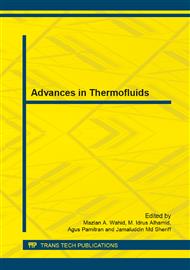p.34
p.40
p.47
p.52
p.58
p.63
p.71
p.76
p.83
Analysis of Small Bubble Characteristics in Alum Solution
Abstract:
Understanding the dynamics of bubbles is necessary in an effort to increase the efficiency of separation of flotation process. The purpose of this research was to study characteristics of small bubbles (bubbles with diameter of 0.2-1 mm), which rise in a liquid column. Experimental set up was a column made of an acrylic pipe with inner diameter of 8.4 cm and length of 200 cm. Small bubbles were generated by copper cathode. The dynamics of bubbles were observed using a video camera. Video images were processed using image processing software. The results indicate that at height of 50 cm from cathode tip bubbles in average have reached its terminal velocity. It has been proven that effect of alum surfactant can reduce the bubbles terminal velocity.
Info:
Periodical:
Pages:
58-62
Citation:
Online since:
August 2013
Authors:
Price:
Сopyright:
© 2013 Trans Tech Publications Ltd. All Rights Reserved
Share:
Citation:


